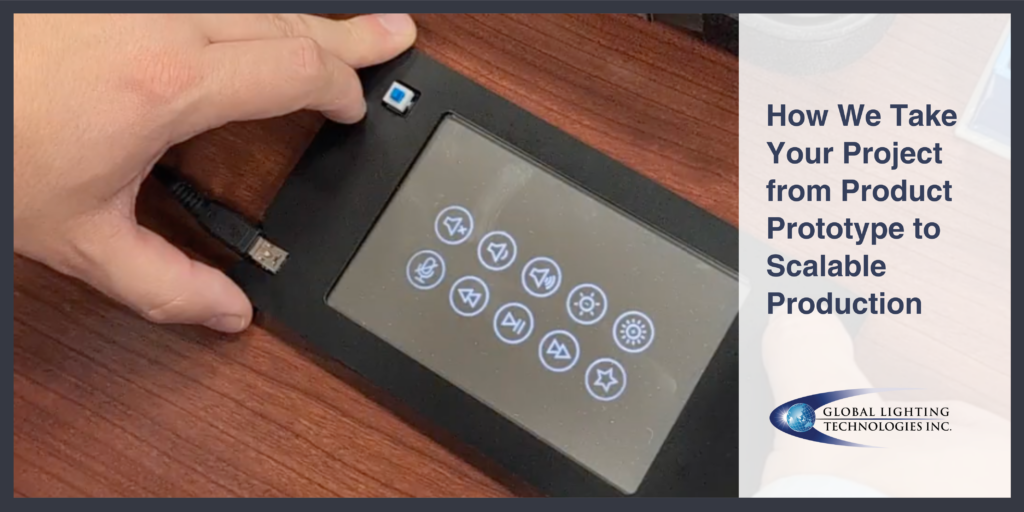
A successful product prototype bridges the gap between an idea and full-scale manufacturing. While it’s simple to explore the possibilities of your product or assembly, the challenge lies in turning a concept into a scalable, production-ready solution.
As someone who has guided countless OEMs through this critical transition, I’ve seen how prototype success can reduce risk, lower costs, and speed time to market.
Read on to learn about:
- The important role of prototyping
- How our prototypes are designed to inform scalable manufacturing
- Prototype to production timelines
- Testing, validation, and quality assurance
The Critical Role of Prototyping in Product Development
Product prototype development builds confidence and momentum for your entire project in addition to creating a physical part. I remember working with a customer on an AED project where the prototype became the turning point for their entire team.
After a significant time investment in the concept, they finally had a functional light guide prototype in their hands that lit up. Their excitement was infectious as they carried it around to team members, reigniting motivation over the long development cycle.
This is why our proven prototype methodology is so crucial. Prototypes give you that first glimpse of what your final product will look like, moving beyond simulations and renderings to something tangible. More importantly, they provide the proof of concept that stakeholders, upper management, and marketing teams need to see before approving the next phase of development.
Product prototype development is also a critical risk reduction tool. Without it, you’re essentially gambling with production costs. I’ve witnessed projects where last-minute changes could have derailed everything, but because we had a working prototype to demonstrate the concept early on, those potentially costly modifications were avoided.
Design for Scalable Manufacturability
One of the biggest misconceptions I encounter is that moving from prototype to production is simply a matter of “copy and paste.” The truth is that prototype designs are rarely optimized for large-scale production due to material choices, geometries, and manufacturing constraints. Our customers appreciate that we iterate and prototype at our U.S. headquarters because our turnaround times are quicker; however, we often face the challenge of injection molding requirements.
When customers’ final assemblies have complex shapes with hooks, snaps, and mechanical features, we forgo expensive injection molding tooling for the prototype. Instead, we focus on what really matters: the optics.
We explain to customers that while mechanical features are important, the real question for a prototype is whether the light guide performs its intended function. Instead of expensive tooling, we can provide alternative designs that deliver the optical performance they need to evaluate, even if the mechanical fit isn’t perfect.
For customers requiring more complex optics and mechanical features, we can CNC machine parts and add optical extraction features through post-processing. While this limits us to smaller sample quantities—typically five parts at most—it provides a more representative light guide prototype for early evaluation.
The key is understanding that your product prototype is based on early concepts that will inevitably change. Customers have been known to modify housing colors, adjust dimensions, and refine their overall design throughout the development process. Each change affects the optics, requiring us to iterate and adapt our designs accordingly.
Navigating the Prototype to Production Timeline
The transition from product prototype to production involves completely different processes and timelines. Our typical prototype development takes four to six weeks, including:
- Material acquisition
- Manufacturing
- Two to three iterations
This timeline accounts for the fact that we often work with early-stage customer designs that are still evolving. However, prototype manufacturing processes bear little resemblance to production methods. While we might use specialized cutting techniques for prototypes, our production processes rely on injection molding and embossing (extrusion embossing or roll-to-roll embossing). A production injection molding machine might have a 30-second cycle time, compared to days of work required for a single product prototype.
This difference in manufacturing approaches means that prototype development requires extensive upfront planning. Our leadership team conducts thorough Design for Manufacturability (DFM) reviews before creating any product prototypes. This ensures that the significant time and resources we invest in drawing reviews, quotations, and approvals are well considered.
Pre-production encompasses everything from initial prototyping through final production drawings and pricing approval. Product prototype development is just one chapter in this larger story, but it’s a critical one that sets the foundation for everything that follows.
Testing, Validation, and Quality Assurance
One of the most common questions I receive is about quality differences between a product prototype and production parts. The good news is that our testing and validation processes remain consistent regardless of the manufacturing method used.
We use the same camera systems, dark rooms, and measurement protocols across all our global facilities to evaluate both prototype and production parts. This consistency ensures that the brightness and uniformity readings we provide for your light guide prototype will represent what you can expect in production. We document specific measurement points—typically nine, twelve, or fifteen locations—so that every test is conducted identically.
This testing phase becomes even more critical for customers without specific performance targets. We can quantify the performance characteristics of your product prototype so that if you’re satisfied with the visual appearance, we can maintain those exact brightness readings in production.
It’s important to note that while our optical qualifications remain the same, we may overlook certain cosmetic specifications in prototypes that wouldn’t be acceptable in production parts. For example, minor surface imperfections that might be visible on a display would be flagged for production but could be sufficient in a prototype, with the understanding that production processes will eliminate these issues.
Move Forward with Confidence
Successfully transitioning from a product prototype to production requires proactive planning and strong engineering partnerships. Our prototype methodology, developed over years of experience, ensures that we move your project into production with confidence.
If you’re ready to move from concept to scalable manufacturing, let’s start the prototype process together. Tell us about your project to get started.